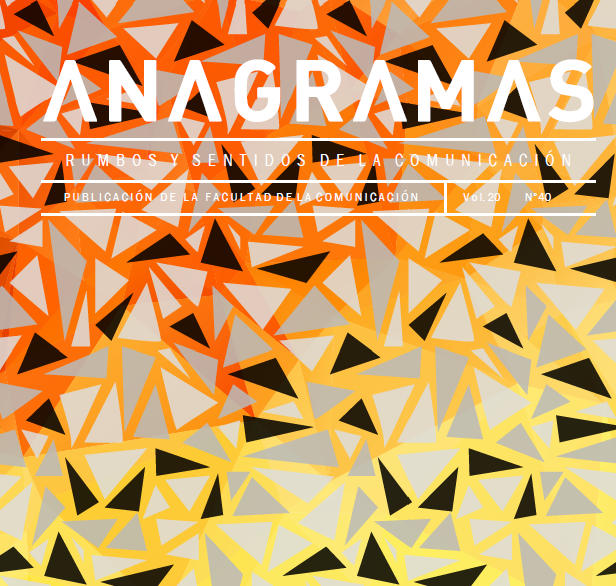Collective Identity Based on Urban Art in Medellín, Colombia
Main Article Content
Abstract
This article collects the partial results of an investigation that proposes to understand the relationship between social groups in the territories and the manifestation of urban art as agents of identity construction, in Medellin, Colombia. The methodology implemented was qualitative, phenomenological, whose scope was descriptive. A content analysis was carried out based on the manifestations of urban art identified and their relationship with the construction of identity based on aesthetic coexistence. Semi-structured interviews were conducted with members of various urban art collectives in the center, west and south of the city, traced from visual ethnography. These territories comprise Comuna 13, the Ayacucho Tramway Corridor and the central and southern zones as an aesthetic unit. Based on this, a historical reconstruction of urban art in Medellín was proposed and the comparative analysis of two types of artistic intervention in the city: the one that arise from local and independent social organizations and the one that is implemented from the institutional framework. As a result, it was found that the urban art of the city has its origins in the independent sociocultural dynamics, which would later be institutionalized, dynamizing historical, social, aesthetic and economic transformation in the intervened environments. Collective identities arise from this process, which are derived from inhabiting the aesthetic, urban and public space, either as an inhabitant and/or as the protagonist of artistic intervention.
Article Details
References
Arenas Grisales, S. P. (2015). Luciérnagas de la memoria. Altares espontáneos y narrativas de luto en Medellín, Colombia. Revista interamericana de Bibliotecología, 38(3), 189-200.
Alcalá, P. R. (2006). Jóvenes, memoria y violencia en Medellín: Una antropología del recuerdo y el olvido. Estudios Políticos, (30), 185-190. Universidad de Antioquia. https://www.redalyc.org/pdf/164/16429058008.pdf
Álvarez Betancur, L. F. (2018). Los puentes de la memoria: jóvenes, arte y memoria en la ciudad de Medellín. http://bibliotecadigital.udea.edu.co/bitstream/10495/10220/1/AlvarezLuisa_2018_PuentesMemoria.pdf
Agudelo-Pérez, L. (2015). Corredor vial de Ayacucho tendrá su propia galería. El Mundo. https://www.elmundo.com/portal/noticias/movilidad/corredor_vial_de_ayacucho_tendra_su_propia_galeria.php#.XH12O8BKiM8.
Allepuz-García, P. (2014). El Street Art y la (in)cultura urbana: el ejemplo de Córdoba. Arte, Individuo y Sociedad, 26(1), 137-151. http://dx.doi.org/10.5209/rev_ARIS.2014.v26.n1.41107
Ardenne, P. (2006). Un arte contextual. Creación artística en medio urbano, en situación de intervención, de participación. Cendeac.
Báscones, P. (2009). El arte público como agente de revitalización urbana mediante la participación ciudadana.
En B. Fernández Quezada y J. P. Lorente Lorente (coord.), Arte en el espacio público: barrios artísticos y revitalización urbana (pp.145-161). Prensas Universitarias de Zaragoza.
Becker, C. (1990). Social Responsibility and the Place of the Artist in Society. Lake View Press.
Castro, S. (2012). Graffiti Bogotá 2012: Diagnóstico Graffiti Bogotá. Informe final Bogotá: [S.E]. https://www.culturarecreacionydeporte.gov.co/sites/default/files/idartes-diagnosticopubli2014.pdf
Ciria, A. (2003). Contra la democratización del Arte. Thémata. Revista De Filosofía, 30(30), 137-155. https://idus.us.es/xmlui/handle/11441/27624
Derrida, J. (1998). Aporías. Paidós.
Garcés H, A. (2006). Configuraciones espaciales de lo inmigrante: usos y apropiaciones de la ciudad. Papeles del CEIC International Journal on Collective Identity Research, 6(20).
Gaviria-Puerta, N.A. (2015). Grafías en la piel de la ciudad: graffiti y pintadas comerciales como expresiones
sociales reflejadas en las calles de Medellín-Colombia [tesis de doctorado, Universidad Politécnica de Madrid]. Archivo Digital UPM. https://oa.upm.es/40330/
Giménez, G. (2000). Materiales para una teoría de las identidades sociales. En J.M. Valenzuela Arce (coord.), Decadencia y auge de las identidades: cultura nacional, identidad cultural y modernización. (pp. 45-78). El Colegio de la Frontera Norte.
González, C., Gómez-Isla, J., del Río, V. y Santamaría, A. (2017). El papel del arte contemporáneo en la dinamización social del entorno urbano. Un estudio de caso: El barrio del Oeste en Salamanca. Arte, Individuo y Sociedad, 29(2), 299-315. http://dx.doi.org/10.5209/ARIS.53165
Hall, S (1990). Identidad cultural y diáspora en Stuart Hall sin garantías. Trayectorias y problemáticas en
estudios culturales. Envión Editores; IEP; Instituto Pensar; Universidad Andina Simón Bolívar.
Hall, S. (1996). Introducción: ¿quién necesita ‘identidad? En S Hall y P. Du Gay (comps.), Cuestiones de identidad cultural (pp. 13-39). Amorrortu.
Jeihhco. (2014) 'Revolución sin muertos' | TEDxTigre. (2014) [Vídeo]. https://www.youtube.com/watch?v=CjOFGkIu5so
López, B. (2017). Las galerías urbanas de memoria en Medellín. Revista de estudios colombianos, (50), 35-49. https://colombianistas.org/wp-content/themes/pleasant/REC/REC%2050/Ensayos/50_9_ensayo_lopez_baquero.pdf
Museo de Antioquia. (2013, 13 de octubre). Pachamama, patologías geográficas. https://museodeantioquia.co/sitio/noticia/pachamama-patologias-geograficas/
Pulgarín, G. H. (2018). Crear y conjurar la crisis de la ciudad. Diseño urbano e imagen de la ciudad en Montpellier, Francia. Revista Kepes, 15(18), 249-277. http://kepes.ucaldas.edu.co/downloads/Revista18_10.pdf
Ruiz Espinal, M. (2016). En Medellín el arte narra la historia y promueve la transformación social. Bitácora,
Silva, A. (2014). Atmósferas ciudadanas grafiti, arte público, nichos estéticos. Quipus; Ciespal.
Taguenca-Belmonte, J. (2016). La identidad de los jóvenes en los tiempos de la globalización. Revista
Mexicana de Sociología, 78(4). http://revistamexicanadesociologia.unam.mx/index.php/rms/article/view/57234/50780
Villalba, P. (2012). Entre ruinas, lugares y objetos residuales de la memoria. Medellín, Colombia:
Universidad Nacional de Colombia.





